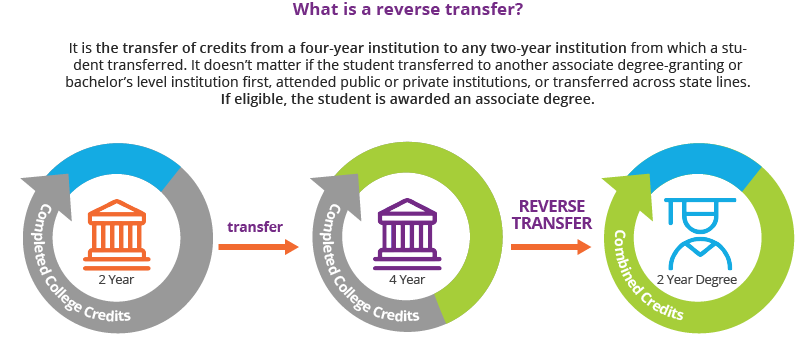- BLOG HOME
- »
- Transcript & Data Exchange Services
- »
- 5 Questions to Ask for Reverse Transfer Success

5 Questions to Ask for Reverse Transfer Success
1. What is reverse transfer?
Reverse transfer is when a student transfers from a 2-year institution, without receiving an associate degree, to a 4-year institution. Reverse transfer provides a means for the 4-year institution to send back to the 2-year institution any earned credits for that student. The combined total credits between the two institutions can then be applied towards an associate degree.
2. What are the benefits of earning an associate degree through reverse transfer?
Students are starting later, they are enrolling part-time, and they are changing institutions. Reverse transfer offers a solution to support the changing and unpredictable needs of students today.
An associate degree provides students with a recognized and meaningful credential that can increase their potential for getting a job and for earning a raise. Studies show that completing an associate degree yields on average approximately $4,600 to $7,200 per annum in extra earnings compared to entering college but not completing an award. In addition, the research shows some states realize an increase of 5-18 percent in bachelor’s degrees at the state level, indicating that a student who gets a degree because of reverse transfer is more likely to stay and complete his/her bachelor’s degree.
3. What’s required for managing FERPA?
The Clearinghouse has compiled the following FERPA best practices that your institution may find helpful as part of your reverse transfer program. Collecting FERPA consent includes:
- Admission Application: Add a question to your admissions application asking students if they are interested in participating in reverse transfer.
- Transcript Requests: Collect reverse transfer FERPA consent whenever a student requests that a transcript be sent to another institution. While this type of consent exchange requires collaboration, it can prove efficient in some circumstances.
- Email Campaigns: Send emails that drive students to a web form or to reply back to opt into your reverse transfer program and give consent for their records to be exchanged. Be aware that this approach tends to yield the lowest response rate, about 10 percent.
- Student Self-Service: If available, use your student information system’s pop-up menus and/or surveys to collect FERPA consent for reverse transfer.
4. How does the Clearinghouse’s Reverse Transfer service help institutions?
Institutions benefit in multiple ways, including:
- The ONLY national solution to enable course and grade data exchanges across state lines for awarding degrees
- Helps improve transfer student retention and graduate rates
- Alleviates reverse transfer workload for community colleges and universities:
- Only one course grade data file submission is required from sending institution
- Eliminates the need to send transcripts throughout the semester
- Ability to consult with our national experts on best practices from across the U.S.
- Dedicated implementation team to guide you through account set-up and file testing, including implementation on most SIS platforms
5. How can my institution participate in the Clearinghouse’s Reverse Transfer service?
With nearly 400 institutions nationwide participating in the Reverse Transfer service, the Clearinghouse is committed to helping all students receive the degree they have earned. To learn more on how Reverse Transfer can help your school and students, visit www.reversetransfer.org.

Additional Resources:



